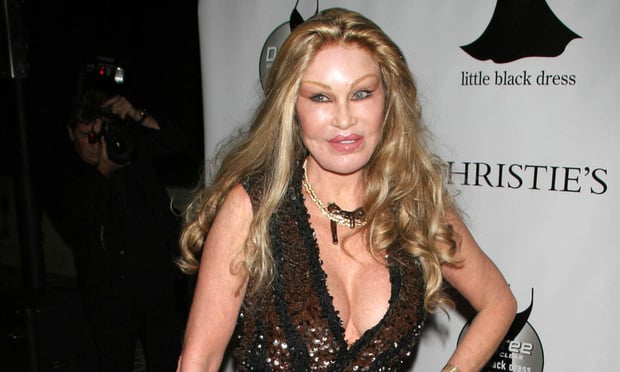'Catwoman,' a Bankrupt New York Socialite, Owes Big Money to Her Lawyers
Jocelyn Wildenstein, who once snagged $2.5 billion in a massive divorce settlement, now owes more than $300,000 to various lawyers and law firms.
May 22, 2018 at 03:07 PM
3 minute read
 Jocelyn Wildenstein
Jocelyn Wildenstein
New York socialite Jocelyn Wildenstein, nicknamed the “Catwoman” because of how plastic surgeons have altered her appearance, filed for bankruptcy this month in Manhattan.
Wildenstein's bankruptcy comes nearly two decades after she received a reported $2.5 billion in her divorce from former French billionaire Alec Wildenstein, an art dealer and horse enthusiast who died in 2008. The split between the Wildensteins, covered in a 1998 feature story in Vanity Fair, resulted in one of the largest settlements in history.
In her personal Chapter 11 filing, Jocelyn Wildenstein lists more than $300,000 in debts owed to various lawyers and law firms. They include $124,605 to Carter Ledyard & Milburn; $78,474 to New York's Matalon Shweky Elman; $70,000 to litigator John Mavroudis in Oradell, New Jersey; $30,431 to New York's Department of Labor for labor law obligations; and an undisclosed sum to The Deiorio Law Group in Rye Brook, New York.
“It's a regular Chapter 11 case,” said bankruptcy lawyer Douglas Pick, a name partner at New York's Pick & Zabicki representing Wildenstein in the matter.
In court filings, Pick's firm said it has received $10,000 as compensation for representing Wildenstein in her bankruptcy. Pick himself sounded somewhat annoyed at answering questions from a reporter about his quasi-famous client, who has received a barrage of news coverage since she sought Chapter 11 protection earlier this month.
“She owes money to lawyers. I don't know if it's a lot,” said Pick about Wildenstein, who listed assets of $16.39 million against $6.38 million in liabilities in her Chapter 11 case.
Those assets include a double unit apartment valued at $11.75 million at the United Nations Plaza building in midtown Manhattan, as well as a 2006 Bentley now worth less than $35,000.
Pick may not be the last lawyer that Wildenstein hires.
Wildenstein recently told the New York Post's Page Six, which frequently updates its readers about the so-called Catwoman, that she is planning on suing her trust. The trust was set up as part of her divorce from her late husband and was “guaranteed” by a painting by Diego Velázquez.
According to the Post and Wildenstein, that painting turned out to be a forgery, and another art work by Paul Cézanne turned out to be worth much less than expected.
This content has been archived. It is available through our partners, LexisNexis® and Bloomberg Law.
To view this content, please continue to their sites.
Not a Lexis Subscriber?
Subscribe Now
Not a Bloomberg Law Subscriber?
Subscribe Now
NOT FOR REPRINT
© 2025 ALM Global, LLC, All Rights Reserved. Request academic re-use from www.copyright.com. All other uses, submit a request to [email protected]. For more information visit Asset & Logo Licensing.
You Might Like
View All

Brownstein Adds Former Interior Secretary, Offering 'Strategic Counsel' During New Trump Term
2 minute read

Weil, Loading Up on More Regulatory Talent, Adds SEC Asset Management Co-Chief
3 minute readTrending Stories
- 1How ‘Bilateral Tapping’ Can Help with Stress and Anxiety
- 2How Law Firms Can Make Business Services a Performance Champion
- 3'Digital Mindset': Hogan Lovells' New Global Managing Partner for Digitalization
- 4Silk Road Founder Ross Ulbricht Has New York Sentence Pardoned by Trump
- 5Settlement Allows Spouses of U.S. Citizens to Reopen Removal Proceedings
Who Got The Work
J. Brugh Lower of Gibbons has entered an appearance for industrial equipment supplier Devco Corporation in a pending trademark infringement lawsuit. The suit, accusing the defendant of selling knock-off Graco products, was filed Dec. 18 in New Jersey District Court by Rivkin Radler on behalf of Graco Inc. and Graco Minnesota. The case, assigned to U.S. District Judge Zahid N. Quraishi, is 3:24-cv-11294, Graco Inc. et al v. Devco Corporation.
Who Got The Work
Rebecca Maller-Stein and Kent A. Yalowitz of Arnold & Porter Kaye Scholer have entered their appearances for Hanaco Venture Capital and its executives, Lior Prosor and David Frankel, in a pending securities lawsuit. The action, filed on Dec. 24 in New York Southern District Court by Zell, Aron & Co. on behalf of Goldeneye Advisors, accuses the defendants of negligently and fraudulently managing the plaintiff's $1 million investment. The case, assigned to U.S. District Judge Vernon S. Broderick, is 1:24-cv-09918, Goldeneye Advisors, LLC v. Hanaco Venture Capital, Ltd. et al.
Who Got The Work
Attorneys from A&O Shearman has stepped in as defense counsel for Toronto-Dominion Bank and other defendants in a pending securities class action. The suit, filed Dec. 11 in New York Southern District Court by Bleichmar Fonti & Auld, accuses the defendants of concealing the bank's 'pervasive' deficiencies in regards to its compliance with the Bank Secrecy Act and the quality of its anti-money laundering controls. The case, assigned to U.S. District Judge Arun Subramanian, is 1:24-cv-09445, Gonzalez v. The Toronto-Dominion Bank et al.
Who Got The Work
Crown Castle International, a Pennsylvania company providing shared communications infrastructure, has turned to Luke D. Wolf of Gordon Rees Scully Mansukhani to fend off a pending breach-of-contract lawsuit. The court action, filed Nov. 25 in Michigan Eastern District Court by Hooper Hathaway PC on behalf of The Town Residences LLC, accuses Crown Castle of failing to transfer approximately $30,000 in utility payments from T-Mobile in breach of a roof-top lease and assignment agreement. The case, assigned to U.S. District Judge Susan K. Declercq, is 2:24-cv-13131, The Town Residences LLC v. T-Mobile US, Inc. et al.
Who Got The Work
Wilfred P. Coronato and Daniel M. Schwartz of McCarter & English have stepped in as defense counsel to Electrolux Home Products Inc. in a pending product liability lawsuit. The court action, filed Nov. 26 in New York Eastern District Court by Poulos Lopiccolo PC and Nagel Rice LLP on behalf of David Stern, alleges that the defendant's refrigerators’ drawers and shelving repeatedly break and fall apart within months after purchase. The case, assigned to U.S. District Judge Joan M. Azrack, is 2:24-cv-08204, Stern v. Electrolux Home Products, Inc.
Featured Firms
Law Offices of Gary Martin Hays & Associates, P.C.
(470) 294-1674
Law Offices of Mark E. Salomone
(857) 444-6468
Smith & Hassler
(713) 739-1250









